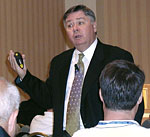
At a time when people are wondering about the security of the economy, Treadway's comments struck a chord during his presentation on "20/20 Foresight: Looking Into the Future of the Mechanical Service Industry."
"Like the meteorologists, your forecast and actions should account for the variables and adjust as time progresses," Treadway said to the contractors. "When the future moves closer, we can be more specific. Hurricane forecasters give a range and margin for error," which is appropriate for forecasting.
He said most people try to offer a best-guess scenario when they try to predict the future. The biggest mistakes in this method are:
"Social change, trade and other government policy, consumer behavior, globalization, demographic shifts, and many other factors could have a greater effect than mechanical service issues."
"Could there be an economic reversal in North America right now? We've got to face the possibility."
Do It Yourself
If the contractors came to the meeting expecting to be handed HVAC service predictions on a platter, they were in for a surprise. Treadway taught the audience how to make their own predictions.First he asked for the contractors to call out their perceived business uncertainties. They offered the following:
"Each of the uncertainties has a finite, predictable range. Further, the uncertainties can be grouped into those in which you have control and those that are out of your control," he said.
"The future is yours to shape but you must be flexibly prepared for events you cannot control. I believe action-ready leaders account for uncertainties, embrace them, and emphasize them in foresight and planning."
Look at a range of relative certainty, he said. "I recommend looking at a range of what's ahead through a ‘cone of relative certainty.' The cone widens as we look forward in time, much the same as the weather forecaster's storm track.
"A useful way to describe this view of the future is to break the cone into different stories of the future or scenarios. These scenarios act as testing grounds for your actions. You want to be able to plan and carry out actions that will succeed in as much of the cone as possible. The scenarios act as ‘wind tunnels to test action.' "
The scenarios become manageable chunks that can be acted upon. Investments, talent, etc., can be predicted for a range of scenarios. "Execute the strategy that works in as many areas as possible, or that can shift."
Treadway said that on Aug. 21, 2001, he attended a meeting of "a large, highly professional board," and told them, "I don't believe that you are prepared for a major catastrophic event in a major metropolitan area outside of your immediate area."
They were able to make some changes that allowed their communications systems to function after the Sept. 11 attacks. Later on they asked Treadway, "How did you forecast that?"
"I didn't," he said. "They did."
"What I suggest is to take a similar approach to the storm trackers," he continued. "After contemplating the uncertainties and the complexities, create a forecast by taking the unpredictable into account.
"The future cannot be predicted with absolute accuracy, but the range of what will happen is finite."

Strategies For The Future
The cone of relative certainty is made up of many elements, he said: trends, driving forces, issues, harbingers (early indicators), and triggers. "It's the combination of these elements that provide implications for action."Forecasting is valuable, he added, but it's not enough. "Forecasting is not the key function. Action is. In order to know what to do, however, we have to visualize the future environment." The Katrina scenario is "what you want to avoid."
The most important components of a future view are the implications for action. Take oil prices over the next three years. Some MSCA audience members predicted they would go as high as $100/barrel or as low as $45/barrel. How would either scenario affect clients' demands, cost control, and implications for business strategies?
He fleshed out a set of four scenarios applicable to the mechanical service field and commodity groups:
Edging wars determine how a contractor fares against competitors. "What are your edges?" According to Treadway, 68 percent of customers switch immediately if they don't get what they want.
"How are customers different from what they were like before?" he asked. The audience replied that customers are smarter, they want it now, they have more access to information, and they are overworked. Treadway confirmed that this is part of a more general opinionated buyer trend:
The group predicted that future customers will demand customization, options, and choices. They will have less time for face-to-face meetings. And, they will expect flawless, immediate performance.
The edging war is measured by two factors: price and perceived value. "When a new product or service is introduced, its perceived value is high," Treadway said.
When competitors emerge, the first thing they do is start underpricing. The perception of the product's value is still high, but you can buy it anywhere. Some examples of this in today's market include PCs, airline tickets, and cell phones.
Segmentation of the market occurs based on price and perceived value. Ultimately there is a price squeeze, a drive to "ultimate value" for the lowest possible cost.
There are three ways to compete, Treadway said: price, value, and specialization. Differentiation is a point of difference based on customer needs. "Differentiation takes place in the mind of the customer," he said. Ways to achieve differentiation include:
Staffing Paradox
It is generally noted that quality staff seems to be in shorter supply, "But will you actually need more?" Treadway asked. There may be a flux of available employees due to other types of jobs being sent offshore. "If you want a job that's not going to be offshored, become a plumber," he said.In the long-term view for construction trades, Treadway noted the following:
Solutions may include:
Bright Horizon?
In The Wisdom of Crowds by James Surowiecki, chief executive officers of prominent companies projected their sales, capital spending, and employment for the next six months. Before hurricanes Katrina and Rita hit, these executives predicted increases in sales, capital spending, and employment.
Their opinions are worth noting and tracking into the future, Treadway said. "These are your customers."
Sidebar: Read A Book
Futurist Bob Treadway, of Treadway & Associates (www.trendtalk.com), gave the following reading list to MSCA contractor-members:
Publication date: 12/19/2005



